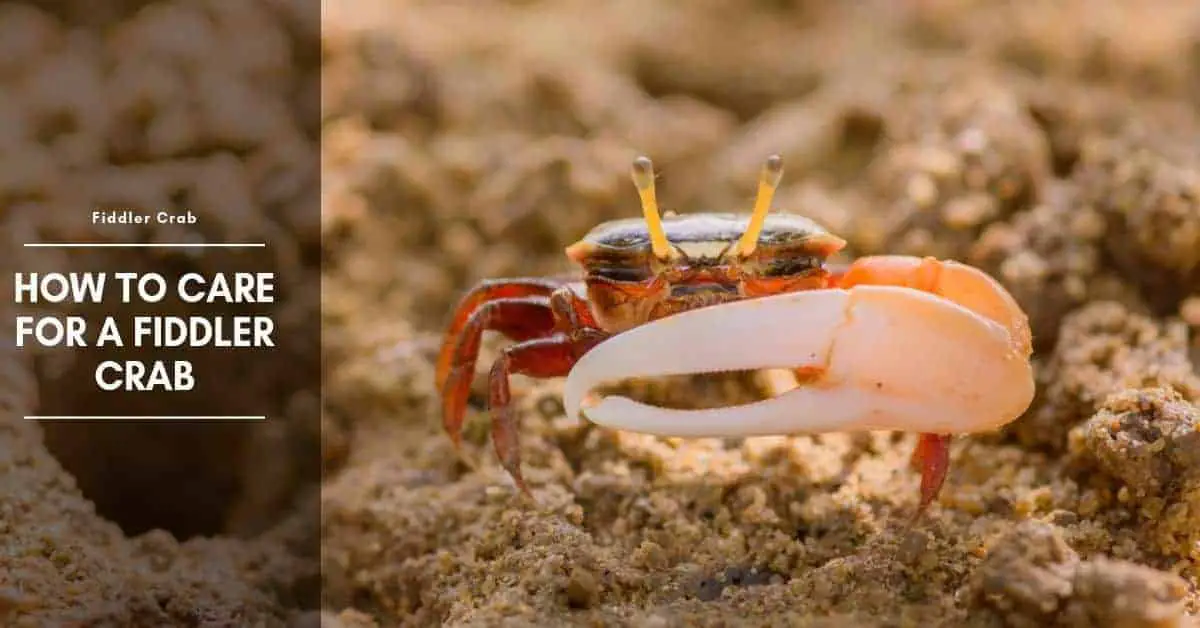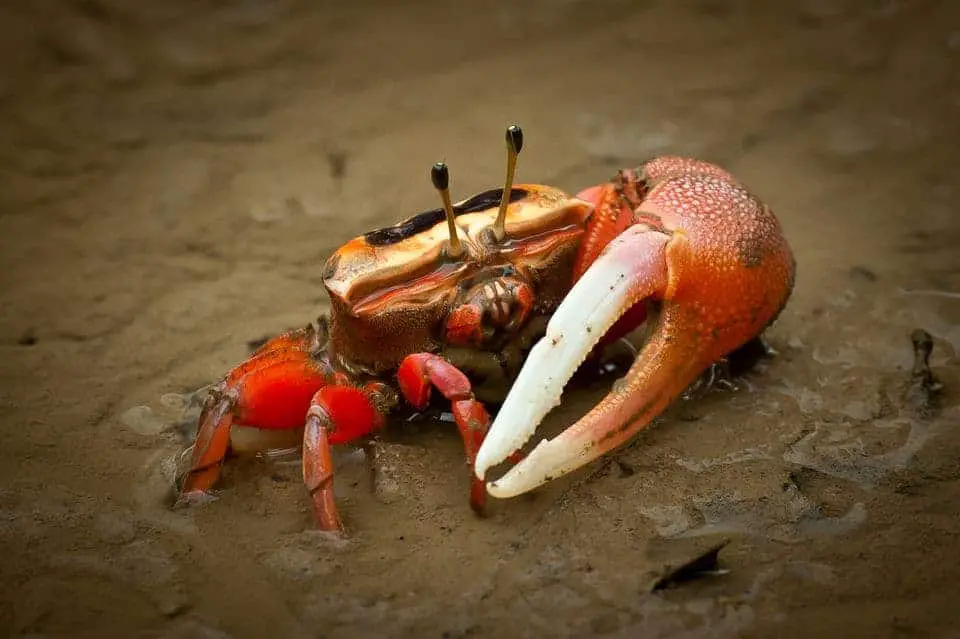In the wild, fiddler crab lives in areas with lots of coverage. This means that coarse rocks like lava rocks and other natural caves are needed. A tank size minimum of 5.5 gallons will suit three small fiddler crabs; two females, one male.
| Care Level | Easy |
| Temperature | 75-85° F |
| KH | 12-30 |
| pH | 8.0-8.3 |
| Maximum size | 1.5-2″ |
| Lifespan | 2 years |
Fiddler Crab Care And Habitat
Sand is very important in a fiddler crab tank. Do NOT place your freshwater crabs on gravel, as this will break their legs and make it extremely difficult for the crabs to climb and move. In my tank, I use very well-rinsed play sand from the department store. Make sure to buy lots of it… you’ll need it to bank up sand to form the land section of the tank.
Fiddler Crabs are semi-aquatic animals, which means they require both land AND water.
What Do Temperature Fiddler Crabs need?
Despite the information that most pet stores give, Fiddler crabs require warm brackish water – about 75-85° F.
These crabs need brackish water
This is a mix of fresh and saltwater. To make this mixture, use both water conditioner and marine salt from the pet store. Do NOT use table salt.
Your tank should also have a hood/lid. Fiddler crabs are amazing climbers and escape artists.
Tetra AquaSafe Plus, 8.45 Ounces, aquarium Water Conditioner And Dechlorinator, Model Number: 46798162681
$8.49 (as of July 13, 2024 06:40 GMT +03:00 - More infoProduct prices and availability are accurate as of the date/time indicated and are subject to change. Any price and availability information displayed on [relevant Amazon Site(s), as applicable] at the time of purchase will apply to the purchase of this product.)API TAP WATER CONDITIONER Aquarium Water Conditioner 16-Ounce Bottle
(as of July 13, 2024 06:40 GMT +03:00 - More infoProduct prices and availability are accurate as of the date/time indicated and are subject to change. Any price and availability information displayed on [relevant Amazon Site(s), as applicable] at the time of purchase will apply to the purchase of this product.)API STRESS COAT Aquarium Water Conditioner 4-Ounce Bottle (85B)
40% OffFiddler Crab Tank Setup
A light source should also be set up on the tank to represent natural daytime and nighttime. This light fixture should be able to keep the tank warm, but not hot. Do not overheat your tank, as this will seriously injure or kill your fiddler crabs. If you’re having trouble keeping the water warm but the tank not too warm, invest in an aquarium heater. The size and wattage of the heater depending on the size of your tank and water volume.
Do Fiddler Crabs Need A Filter?
Filtering a crab tank is optional. If you want a more natural setup and have trouble hiding a filter, just do more frequent water changes. Also, if you prefer a filter, go with an internal filter. Otherwise, the crabs will climb up the intake tube and find a way out of the tank. A good filter for a crab tank can be found here. I do not have a filter in my 5.5-gallon tank and do water changes every few days. Fiddler crabs are not very messy animals.
You can use bubbler instead of filter
If you prefer not filtering the tank, buy a bubbler wand and bury it in the sand. The bubbles will keep the water moving, so no protein buildup will form.
Feeding Fiddler Crabs
Feed the crabs small amounts of food daily. Take out any remaining food 12 hours after it was put in the tank to prevent the water from clouding.
What do fiddler crabs eat?
In the wild, he mostly eats algae and any small creatures he finds, in captivity, you can feed these crabs with Hikari Crab Cuisine, or with Algae & Spirulina.
Difference between male and female
Male Fiddler crabs have one small claw and one large claw, while females have two small claws. When purchasing Fiddler crabs for your tank, do not overcrowd the tank. The recommended female to male ratio is 2:1, which means 2 females per male. Keep in mind that the crabs will grow.
Fiddler Crabs Molting
This means that every once in a while they will shed their exoskeleton to grow. During this short period, the crab will act slow, and then finally flip over onto its back to finish the process. It is important not to bother or touch the crab. Afterward, there will be an exoskeleton left behind.
Also, do not force the crabs to be active. They are not pets that you can hold or handle and are extremely fragile animals. It is their natural instinct to hide behind rocks and burrow into sand most of the day. Handling these crabs will most likely result in stress and/or death.
Fiddler Crabs Tank Mates
And finally, Fiddler crabs should be kept in groups of two or more. They are social animals and prefer to be together. However, keeping fish in the tank with them is not a good idea. The crabs will try to catch the fish as an instinct for food.
For more information about other crab species click here.

Hi, my name is Sean, and I’m the primary writer on the site. I’m blogging mostly about freshwater and saltwater aquariums, fish, invertebrates, and plants. I’m experienced in the fishkeeping hobby for many years. Over the years I have kept many tanks, and have recently begun getting more serious in wanting to become a professional aquarist. All my knowledge comes from experience and reading forums and a lot of informative sites. In pursuit of becoming a professional, I also want to inspire as many people as I can to pick up this hobby and keep the public interest growing.
Read more about Sean.
Please join also my Facebook group.





















